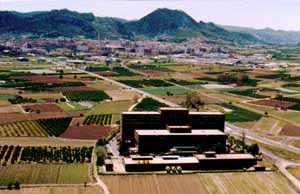| Paper # 017 | Versión
en Español |
| Paper # 017 | Versión
en Español |
Dr. Pascual Meseguer García, Dr. Francisco García Herreros, Dra. Mª José Roca Estellés, Dr. Álvaro Gómez Castro, Dr. Jorge Escandón Álvarez.
Department of Pathology. Hospital Lluìs Alcanyìs. Xátiva. Valencia. Spain.
Address: Ctra.
Xàtiva-Silla, km 2,
Xàtiva 46800 (Valencia) Spain.
![]() [Introduction] [Materials
& Methods] [Results] [Pictures] [Discussion]
[Bibliography]
[Introduction] [Materials
& Methods] [Results] [Pictures] [Discussion]
[Bibliography] ![]()
The diagnosis of a mycotic infection is usually made on the basis of morphologic recognition of fungi in histological sections. Artifacts and organic structures similar to fungi may arise some problems in the interpretation, due to a very similar appearance to real fungi and their frequent positivity with silver metenamine and PAS. It is an heterogeneous group of forms and the have been classified in two groups: Yeast-like pseudofungi and Hyphalike pseudofungi (1).
We present a case of hyphalike pseudofungus in lymph node, of which only two cases have been described previously in the literature (2,3). The patient was a 74 years old male that underwent a nephrectomy + ureterectomy for a transitional cell carcinoma of the ureter. During surgical intervention a adenopathy in right renal hilum was noted, that was excised and corresponds to this study.
The lymph node was 1,4 cm in largest diameter, Microscopically, in H-E numerous hypha-like structures (pseudohyphae) were observed, and they were arranged haphazardly in lymph node sinus, with an amphophil staining. They are branched with variable angles and multiple fragmentation that resemble the hypha septa. They showed intense staining with Perls and less pronounced with silver metenamine, Gomori and Ziehl-Neelsen; however, they were negative with von Kossa and PAS. The differential diagnoses includes septated fungi such as Aspergillus, Fusarium and Mucor.
The best means to achieve a correct diagnosis is the histological suspicion that they are not real fungi due to its variable thickness and branching angle, as well as the strong positivity with Perls staining, not only in this case, but also in the two previously reported ones. The matrix above which iron deposits are formed is unknown in lymph nodes, although Connely and Teague suggest that it is abnormal collagen fibers, due to its resemblance with those observed in Gamma Gandy bodies of the spleen. We discuss about the pathogenesis of this phenomenon, that might be related to congestion and lymph node hemorrhage.
1. Gorelkin L, Chandler FW. Pseudomicrobes: some potential diagnostic pitfalls in the histopathologic assessmen of inflammatory lesions. Hum Pathol. 1988; 19: 954-959.
2. Connelly J, Ro JY, Cartwright J. Pseudofungi in a lymph node: a case report with energy dispersive x-ray elemental analysis. Arch Pathol Lab Med. 1991; 115: 1166-1168.
3. Teague MD, Tham KT. Hyphalike pseudofungus in a lymph node. Arch Pathol Lab Med. 1994; 118: 95-96.

Dr. Pascual Meseguer García (picture), Dr. Francisco García Herreros and Dra. Mª José Roca Estellés are staff pathologists at the Pathology Department of the Hospital Lluís Alcanyís in Xàtiva. Dr. Álvaro Gómez Castro is Head of Section, and Dr. Jorge Escandón Álvarez is nowadays working as deputy Director of the Hospital.

Acknowledgements: We thank
the rest of the components of the Department for
their cooperation, specially Natividad Castelló Riglá
for her excellent stainings, and Víctor Vercher
González. We also also grateful to the Computing
Department for their invaluable help in this area.